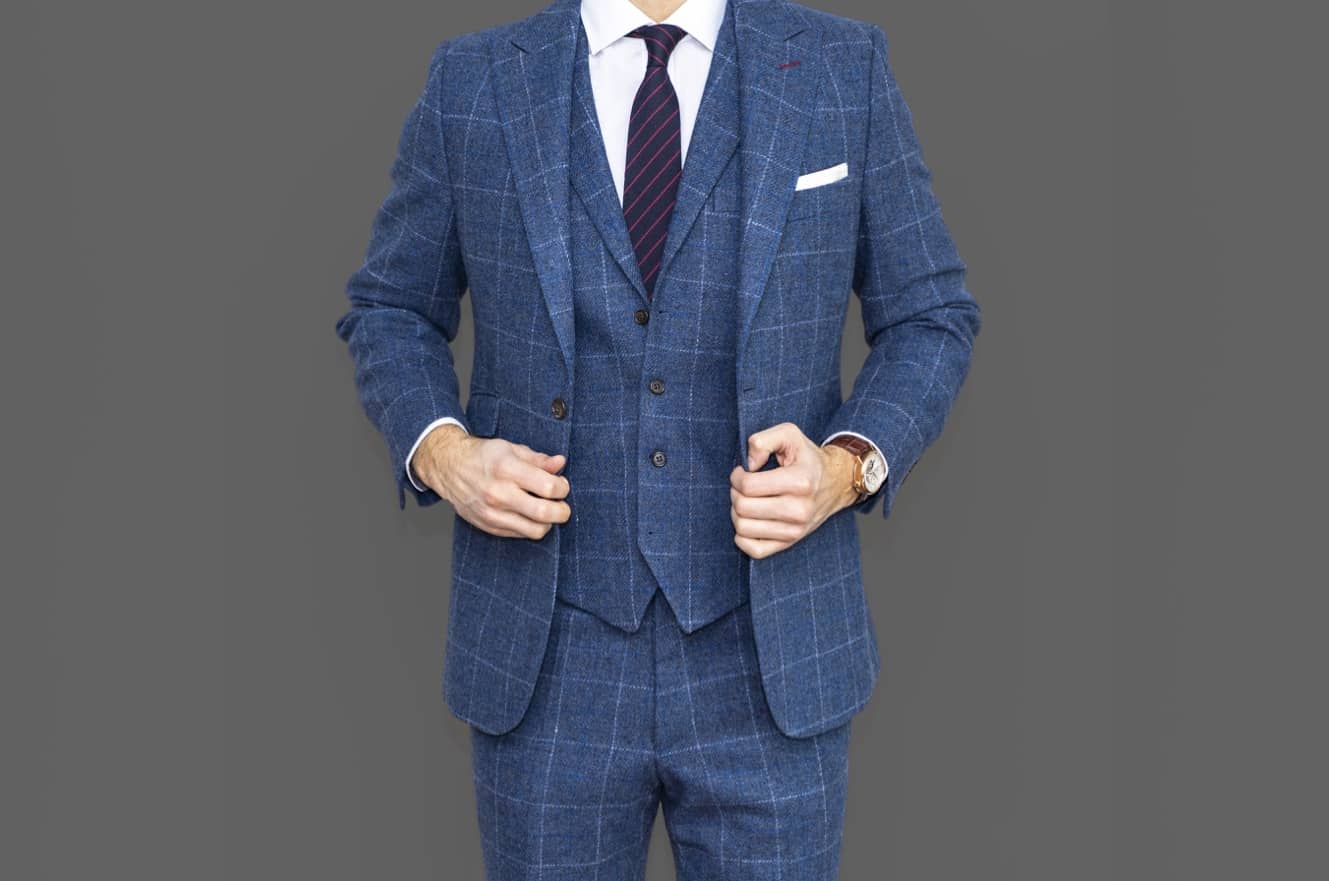
www.buildingsandcities.org/insights/commentaries/clothing-personal-comfort.html
Clothing: The First Layer of Personal Comfort

In the context of the climate and energy crises, clothing can reduce the energy demand associated with thermal comfort.
Alongside personal comfort systems (PCS) devices, clothing is another key site for (re)design in a body-centred personal comfort paradigm. Janine Morley (Lancaster University) explains how clothing and PCS could transform how thermal comfort is achieved whilst delivering energy savings and, potentially, increased satisfaction.
The literature on PCS reconsiders the functions of commercial building systems with the goal of more efficient and highly tailored provision to occupants rather than spaces. As the initiating commentary in this series observes, it is a stretch to include 'wearables such as thermally active clothing' within PCS because such things are not part of the building system (Arens & Zhang, 2022). Yet clothing epitomises a system designed for personal comfort: it helps to keep people adjustably warm or cool without affecting the surrounding environment.
Today's apparel is arguably narrower in 'thermal range' and almost certainly offers less insulation than in the past (Rudge, 2012). At the same time, commercial development of technical textiles for the outdoors and sports markets offer improved warmth-to-weight ratios and wicking compared to traditional textiles. Yet only some of these technologies are incorporated into 'mainstream' garments for everyday home or office wear. Little attention appears to be paid to the thermal performance of everyday clothing. In a paradigm that views thermal comfort provision as synonymous with the operation of heating, ventilation and air conditioning (HVAC) systems (Shove, 2003), this is not surprising.
How might the potential of clothing be better harnessed, as part of an alternative, personal comfort paradigm? Two key aspects are considered: thermal innovations in textiles and the prospect of change in collective conventions and styles of dress.
New thermoregulatory garments
A growing body of research in 'personal thermal management' is developing innovative thermoregulatory textiles and garments specifically with the aim of saving energy in buildings by enabling a wider range of HVAC system setpoints (Chai & Fan, 2022; Peng & Cui, 2020). Energy savings vary depending on local climate, building insulation and baseline temperature but are usually equated to a 10% reduction in annual energy use for each degree Celsius beyond standard heating and cooling setpoints (Hoyt et al., 2015; Palmer et al., 2012).
There are many promising lines of development (cf. Peng and Cui, 2020). Active garments require additional energy from an integrated battery for heating or a cooling fan. Passive garments focus on the engineering of the textile structure itself including the control of conduction from the body (which is what most forms of clothing insulation do), hygrothermal properties (e.g. as in wicking sportwear) and responsive textiles that change structure according to conditions. Perhaps the most promise lies with textiles that control for radiation; this accounts for a large component of body heat loss in a sedentary indoor environment which conventional textiles do very little to prevent (Peng & Cui, 2020). For instance, Cai et al. (2017) have shown that cotton laminated on the outer surface with a nanoporous metallized polyethylene layer dramatically minimises infrared heat loss to the extent that 15°C would be comfortable, compared to 22°C for the same garments made with conventional textiles.
Advanced passive thermoregulatory garments are already on sale in many countries. For example, one brand's textile incorporates micro gold dots to reflect radiative body heat, whilst allowing for breathability. It is used primarily in outerwear, such as jackets, but is also available in base-layers such as tights (leggings) and sweaters. Another brand also sells an infrared reflective fabric which they claim makes their coats, smart and casual wear 30% warmer than comparable garments. They also market the 'world's first infrared-transparent' fabric for keeping cool. Another company sells advanced office clothing including a dress shirt made with a breathable phase-change material first developed by NASA that absorbs or releases heat depending on the temperature. Whilst these advanced passive textiles are, so far, limited to niche apparel, they nevertheless have potential to influence mainstream fashion markets and debates in the industry.
In contrast, active thermal garments already appear to be lurking at the edges of the mainstream, thanks to the energy crisis. Heated gilets (vests) and jackets, as well as insoles, socks and gloves are accessibly priced and have been widely available via online outlets for a number of years, usually marketed in outdoor wear or sports categories. But there are signs of new consumer interest as the Northern hemisphere heads into a winter of record energy prices. For instance, the UK's Money Saving Expert has reluctantly advised readers looking to reduce energy bills to "Heat the human, not the home" (Munro, 2022) by using electric heated gloves, insoles and gilets, amongst other things. The current energy crisis may provide an impetus for households to experiment with lower-energy, personal comfort approaches more generally, including more emphasis on clothing, blankets and local heating devices, such as heated throw rugs.
Improving the thermal quality of mainstream clothes
Cutting-edge textile technologies and active garments are not the only way to extend HVAC setpoints: much is already possible within the range of readily available clothing and textiles. According to the thermal balance equation, increasing clothing insulation (clo) by 1 unit can reduce the comfort temperature by about 6°C (ASHRAE, 2017). Although Fanger (1970) described a 1.5 clo ensemble of a 'heavy traditional European business suit' for which the optimum sedentary comfort temperature is around 18°C (Parsons, 2010) ASHRAE standards have long equated winter dress with 1 clo, no doubt reflecting a change in conventions towards 'lighter' winter dress. Now consider that summer air temperatures in North American office buildings converge around the 1 clo range rather than that appropriate for 0.5 clo 'summer dress' (Zhang et al., 2015) and there is clear scope for extending setpoints in both directions. Interventions designed to address dress codes could do this.
The Japanese Cool Biz initiative, which started in 2005, successfully changed the business dress code thereby enabling a higher cooling setpoint for office buildings. It highlights the important connection between dress and building energy use. Its success involved a number of different elements and stakeholders, addressing multiple aspects of the everyday practices that sustained the previous norm (Shove, 2012). For instance, high profile industrial leaders and politicians were recruited to take part in fashion shows promoting a cooler business dress, with short sleeves and no tie. The campaign had a strong identity which demarked fashion collections in stores and a pin could be worn to communicate to others why your dress diverged from existing conventions.
The case of Cool Biz shows that transformative change occurs through the involvement of multiple stakeholders implicated in the practices that sustain dress conventions, including professional organisations in the case of work wear, and the fashion industry (Shove and Granier, 2018). Changing conventions within contemporary registers of dress could improve thermal microenvironments elsewhere, for instance through increased layering and inclusion of warmer items within everyday home and office wear during winter.
The design of garments is also crucial, and to some degree, inextricable from the challenges of promoting more seasonally appropriate conventions. For instance, there may be opportunities to incorporate existing technical textiles with better thermal qualities into mainstream home and office wear. Ensembles could be designed together to help address the thermal shortcomings of conventional styles, such as better coverage of extremities, and the 'discomforts' of dressing in 'heavier' clothes, such as how well garments layer with other items. More insulating types of garments could also be designed, perhaps through a reinvention of housecoats, dressing gowns and cloaks (Shove, 2020). Underpinning such possibilities, an industry-approved programme to label clothing according to insulation value, much like with duvets, could help to raise the importance of thermal design within the industry and bolster innovation and research.
For politicians faced with spiralling energy costs, the recommendation to the public to 'put on another jumper' is dangerous ground. Nevertheless, there is much the fashion industry could do in the immediate and near-term, with or without government support, to improve the thermal quality of the clothes people wear; even without advanced thermoregulatory textiles. A first step is to recognise the inherent role the industry already plays in specifying and sustaining global demand for space heating and cooling (Sahakian, 2014).
Personal comfort synergies
Clothing deserves more attention as a mechanism of thermal comfort and as an intervention designed to reduce energy use in buildings, in its own right. Clothing could also serve as a close complement to conventional PCS, with which it shares an underpinning philosophy. Compared to 'installed' PCS systems, clothing offers some advantages: it is portable and mobile (Lou et al., 2020) so can be readily carried into a building by the occupant and, when worn, moves with them. Clothing systems may also offer lower costs and ease of implementation than 'installed' PCS solutions, and so may be more readily adopted, particularly in domestic settings (US Department of Energy, 2014).
Clothing design and PCS also interact in ways that affect each other's effectiveness, for instance through exposure to ventilation or conductive heat surfaces, such as chairs, or by overheating some parts of the body that are already well insulated. Thus, a holistic personal comfort approach would encompass both clothing and PCS design, turning such interactions at the level of each segment of the body, into synergies. (Indeed, PCS are already designed, somewhat by necessity, to counter the 'shortcomings' of conventional clothing as the first layer of the microclimate, such as the lack of coverage of the extremities.) There is opportunity to maximise the complementary strengths offered by clothing and PCS, if both are considered together as part of a body-centred personal comfort paradigm.
As Booten et al. (2021) highlight, new forms of thermoregulatory clothing are one of a range of technologies that, together, offer potential to entirely remove the need for centralised conditioning for human thermal comfort. Undoubtedly, a focus on clothing systems differs in important ways from buildings-oriented PCS; it involves different disciplines, stakeholder communities, technologies and responsibilities for implementation. But it also brings new opportunities that it would be remiss, at this point in history, not to pursue.
References
Arens, E., & Zhang, H. (2022). Mainstreaming Personal Comfort Systems [Commentary]. Buildings and Cities. https://www.buildingsandcities.org/insights/commentaries/mainstreaming-personal-comfort-systems.html
ASHRAE. (2017). Thermal Environmental Conditions for Human Occupancy: ANSI/ASHRAE Standard 55-2017 (Supersedes ANSI/ASHRAE Standard 55-2013). American Society of Heating, Refrigerating Air-Conditioning Engineers.
Booten, C., Rao, P., Rapp, V., Jackson, R., & Prasher, R. (2021). Theoretical Minimum Thermal Load in Buildings [Review]. Joule, 5(1), 24-46. https://doi.org/10.1016/j.joule.2020.12.015
Butler, S. L., & Francis, S. K. (1984). Disseminating energy efficient clothing information: a comparison of two methods. Clothing and Textiles Research Journal, 3(1), 9-13.
Cai, L., Song, A. Y., Wu, P., Hsu, P.-C., Peng, Y., Chen, J., Liu, C., Catrysse, P. B., Liu, Y., Yang, A., Zhou, C., Zhou, C., Fan, S., & Cui, Y. (2017). Warming up human body by nanoporous metallized polyethylene textile. Nature Communications, 8(1), 496. https://doi.org/10.1038/s41467-017-00614-4
Chai, J., & Fan, J. (2022). Advanced thermal regulating materials and systems for energy saving and thermal comfort in buildings. Materials Today Energy, 24, 100925. https://doi.org/https://doi.org/10.1016/j.mtener.2021.100925
Fanger, O. (1970). Thermal Comfort. Analysis and applications in environmental engineering.
Hoyt, T., Arens, E., & Zhang, H. (2015). Extending air temperature setpoints: Simulated energy savings and design considerations for new and retrofit buildings. Building and Environment, 88, 89-96. https://doi.org/https://doi.org/10.1016/j.buildenv.2014.09.010
Lapitsky, M., & Dickey, L. E. (1986). Textiles and clothing in thermal energy conservation. Home economics research journal, 14(3), 314-325.
Lou, L., Shou, D., Park, H., Zhao, D., Wu, Y. S., Hui, X., Yang, R., Kan, E. C., & Fan, J. (2020). Thermoelectric air conditioning undergarment for personal thermal management and HVAC energy saving. Energy and Buildings, 226, 110374. https://doi.org/https://doi.org/10.1016/j.enbuild.2020.110374
Munro, S. (2022). Heat the human not the home: Save energy and stay warm with thermals, electric blankets & more. Retrieved 15/09/22 from https://www.moneysavingexpert.com/utilities/heat-the-human-not-the-home-save-energy/
Palmer, J., Terry, N., & Pope, P. (2012). How much energy could be saved by making small changes to everyday household behaviours. A report for Department of Energy and Climate Change.
Parsons, K. (2010). 5 - Thermal comfort in buildings. In M. R. Hall (Ed.), Materials for Energy Efficiency and Thermal Comfort in Buildings (pp. 127-147). Woodhead Publishing. https://doi.org/https://doi.org/10.1533/9781845699277.1.127
Peng, Y., & Cui, Y. (2020). Advanced Textiles for Personal Thermal Management and Energy. Joule, 4(4), 724-742. https://doi.org/https://doi.org/10.1016/j.joule.2020.02.011
Rohles, F. H., & McCullough, E. A. (1981). Clothing as a key to energy conservation [Conference Paper]. Industrial and Engineering Chemistry Product Research and Development, 20(1), 18-23. https://doi.org/10.1021/i300001a600
Rudge, J. (2012). Coal fires, fresh air and the hardy British: A historical view of domestic energy efficiency and thermal comfort in Britain. Energy Policy, 49, 6-11. https://doi.org/https://doi.org/10.1016/j.enpol.2011.11.064
Sahakian, M. (2014). Keeping cool in Southeast Asia: energy consumption and urban air-conditioning. Springer.
Shove, E. (2003). Comfort, cleanliness and convenience: the social organization of normality. Berg.
Shove, E. (2012). Putting practice into policy: reconfiguring questions of consumption and climate change. Contemporary Social Science, 9(4), 415-429. https://doi.org/10.1080/21582041.2012.692484
Shove, E. (2020). Why Social Theory is Important for Energy Research and the Built Environment. https://www.buildingsandcities.org/insights/research-pathways/social-theory-energy.html
Shove, E., & Granier, B. (2018). Pathways of Change: Cool Biz and the Reconditioning of Office Energy Demand. DEMAND Research Insights, #17. http://www.demand.ac.uk/wp-content/uploads/2018/04/demand-insight-17-V3.pdf
US Department of Energy. (2014). DE-FOA-0001127: Delivering Efficient Local Thermal Amenities (DELTA). Retrieved 15/09/2022 from https://arpa-e-foa.energy.gov/Default.aspx?foaId=5f8d77cf-eea3-4fd6-a595-bc96576d097a
Zhang, H., Arens, E., & Zhai, Y. (2015). A review of the corrective power of personal comfort systems in non-neutral ambient environments. Building and Environment, 91, 15-41. https://doi.org/https://doi.org/10.1016/j.buildenv.2015.03.013
Latest Peer-Reviewed Journal Content
Designing for pro-environmental behaviour change: the aspiration–reality gap
J Simpson & J Uttley
Lifetimes of demolished buildings in US and European cities
J Berglund-Brown, I Dobie, J Hewitt, C De Wolf & J Ochsendorf
Expanding the framework of urban living labs using grassroots methods
T Ahmed, I Delsante & L Migliavacca
Youth engagement in urban living labs: tools, methods and pedagogies
N Charalambous, C Panayi, C Mady, T Augustinčić & D Berc
Co-creating urban transformation: a stakeholder analysis for Germany’s heat transition
P Heger, C Bieber, M Hendawy & A Shooshtari
Placemaking living lab: creating resilient social and spatial infrastructures
M Dodd, N Madabhushi & R Lees
Church pipe organs: historical tuning records as indoor environmental evidence
B Bingley, A Knight & Y Xing
A framework for 1.5°C-aligned GHG budgets in architecture
G Betti, I Spaar, D Bachmann, A Jerosch-Herold, E Kühner, R Yang, K Avhad & S Sinning
Net zero retrofit of the building stock [editorial]
D Godoy-Shimizu & P Steadman
Co-learning in living labs: nurturing civic agency and resilience
A Belfield
The importance of multi-roles and code-switching in living labs
H Noller & A Tarik
Researchers’ shifting roles in living labs for knowledge co-production
C-C Dobre & G Faldi
Increasing civic resilience in urban living labs: city authorities’ roles
E Alatalo, M Laine & M Kyrönviita
Co-curation as civic practice in community engagement
Z Li, M Sunikka-Blank, R Purohit & F Samuel
Preserving buildings: emission reductions from circular economy strategies in Austria
N Alaux, V Kulmer, J Vogel & A Passer
Urban living labs: relationality between institutions and local circularity
P Palo, M Adelfio, J Lundin & E Brandão
Living labs: epistemic modelling, temporariness and land value
J Clossick, T Khonsari & U Steven
Co-creating interventions to prevent mosquito-borne disease transmission in hospitals
O Sloan Wood, E Lupenza, D M Agnello, J B Knudsen, M Msellem, K L Schiøler & F Saleh
Circularity at the neighbourhood scale: co-creative living lab lessons
J Honsa, A Versele, T Van de Kerckhove & C Piccardo
Positive energy districts and energy communities: how living labs create value
E Malakhatka, O Shafqat, A Sandoff & L Thuvander
Built environment governance and professionalism: the end of laissez-faire (again)
S Foxell
Co-creating justice in housing energy transitions through energy living labs
D Ricci, C Leiwakabessy, S van Wieringen, P de Koning & T Konstantinou
HVAC characterisation of existing Canadian buildings for decarbonisation retrofit identification
J Adebisi & J J McArthur
Simulation and the building performance gap [editorial]
M Donn
Developing criteria for effective building-sector commitments in nationally determined contributions
P Graham, K McFarlane & M Taheri
Join Our Community

The most important part of any journal is our people – readers, authors, reviewers, editorial board members and editors. You are cordially invited to join our community by joining our mailing list. We send out occasional emails about the journal – calls for papers, special issues, events and more.
We will not share your email with third parties. Read more



Latest Commentaries
COP30 Report
Matti Kuittinen (Aalto University) reflects on his experience of attending the 2025 UN Conference of the Parties in Belém, Brazil. The roadmaps and commitments failed to deliver the objectives of the 2025 Paris Agreement. However, 2 countries - Japan and Senegal - announced they are creating roadmaps to decarbonise their buildings. An international group of government ministers put housing on the agenda - specifying the need for reduced carbon and energy use along with affordability, quality and climate resilience.
Building-Related Research: New Context, New Challenges
Raymond J. Cole (University of British Columbia) reflects on the key challenges raised in the 34 commissioned essays for Buildings & Cities 5th anniversary. Not only are key research issues identified, but the consequences of changing contexts for conducting research and tailoring its influence on society are highlighted as key areas of action.